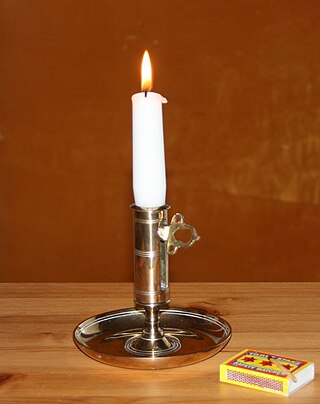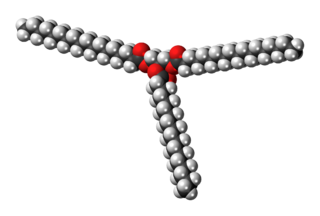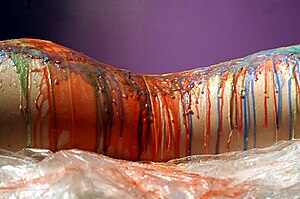
Paraffin wax is a soft colorless solid derived from petroleum, coal, or oil shale that consists of a mixture of hydrocarbon molecules containing between 20 and 40 carbon atoms. It is solid at room temperature and begins to melt above approximately 37 °C (99 °F), and its boiling point is above 370 °C (698 °F). Common applications for paraffin wax include lubrication, electrical insulation, and candles; dyed paraffin wax can be made into crayons. It is not to be confused with kerosene and other petroleum products that are sometimes called paraffin.

Beeswax is a natural wax produced by honey bees of the genus Apis. The wax is formed into scales by eight wax-producing glands in the abdominal segments of worker bees, which discard it in or at the hive. The hive workers collect and use it to form cells for honey storage and larval and pupal protection within the beehive. Chemically, beeswax consists mainly of esters of fatty acids and various long-chain alcohols.

A candle is an ignitable wick embedded in wax, or another flammable solid substance such as tallow, that provides light, and in some cases, a fragrance. A candle can also provide heat or a method of keeping time. Candles have been used for over two millennia around the world, and were a significant form of indoor lighting until the invention of other types of light sources. Although electric light has largely made candle use nonessential for illumination, candles are still commonly used for functional, symbolic and aesthetic purposes and in specific cultural and religious settings.

Waxes are a diverse class of organic compounds that are lipophilic, malleable solids near ambient temperatures. They include higher alkanes and lipids, typically with melting points above about 40 °C (104 °F), melting to give low viscosity liquids. Waxes are insoluble in water but soluble in nonpolar organic solvents such as hexane, benzene and chloroform. Natural waxes of different types are produced by plants and animals and occur in petroleum.

Waxed paper is paper that has been made moisture-proof and grease-proof through the application of wax.

Stearin, or tristearin, or glyceryl tristearate is an odourless, white powder. It is a triglyceride derived from three units of stearic acid. Most triglycerides are derived from at least two and more commonly three different fatty acids. Like other triglycerides, stearin can crystallise in three polymorphs. For stearin, these melt at 54 (α-form), 65, and 72.5 °C (β-form).

Petroleum jelly, petrolatum, white petrolatum, soft paraffin, or multi-hydrocarbon, CAS number 8009-03-8, is a semi-solid mixture of hydrocarbons, originally promoted as a topical ointment for its healing properties. Vaseline has been an American brand of petroleum jelly since 1870.

Surfboard wax is a formulation of natural and/or synthetic wax for application to the deck of a surfboard, bodyboard, or skimboard, to keep the surfer from slipping off the board when paddling out or riding a wave. It is also used to increase grip on the paddle of a surf kayak or dragon boat.

A topical medication is a medication that is applied to a particular place on or in the body. Most often topical medication means application to body surfaces such as the skin or mucous membranes to treat ailments via a large range of classes including creams, foams, gels, lotions, and ointments. Many topical medications are epicutaneous, meaning that they are applied directly to the skin. Topical medications may also be inhalational, such as asthma medications, or applied to the surface of tissues other than the skin, such as eye drops applied to the conjunctiva, or ear drops placed in the ear, or medications applied to the surface of a tooth. The word topical derives from Greek τοπικόςtopikos, "of a place".

Lip balm or lip salve is a wax-like substance applied typically to the lips to moisturize and relieve chapped or dry lips, angular cheilitis, stomatitis, or cold sores. Lip balm often contains beeswax or carnauba wax, camphor, cetyl alcohol, lanolin, paraffin, and petrolatum, among other ingredients. Some varieties contain dyes, flavor, fragrance, phenol, salicylic acid, and sunscreen.

A votive candle or prayer candle is a small candle, typically white or beeswax yellow, intended to be burnt as a votive offering in an act of Christian prayer, especially within the Anglican, Lutheran, and Roman Catholic Christian denominations, among others. In Christianity, votive candles are commonplace in many churches, as well as home altars, and symbolize the "prayers the worshipper is offering for him or herself, or for other people." The size of a votive candle is often two inches tall by one and a half inches diameter, although other votive candles can be significantly taller and wider. In other religions, such as Hinduism and Buddhism, similar offerings exist, which include diyas and butter lamps.
Microcrystalline waxes are a type of wax produced by de-oiling petrolatum, as part of the petroleum refining process. In contrast to the more familiar paraffin wax which contains mostly unbranched alkanes, microcrystalline wax contains a higher percentage of isoparaffinic (branched) hydrocarbons and naphthenic hydrocarbons. It is characterized by the fineness of its crystals in contrast to the larger crystal of paraffin wax. It consists of high molecular weight saturated aliphatic hydrocarbons. It is generally darker, more viscous, denser, tackier and more elastic than paraffin waxes, and has a higher molecular weight and melting point. The elastic and adhesive characteristics of microcrystalline waxes are related to the non-straight chain components which they contain. Typical microcrystalline wax crystal structure is small and thin, making them more flexible than paraffin wax. It is commonly used in cosmetic formulations.

Hot-melt adhesive (HMA), also known as hot glue, is a form of thermoplastic adhesive that is commonly sold as solid cylindrical sticks of various diameters designed to be applied using a hot glue gun. The gun uses a continuous-duty heating element to melt the plastic glue, which the user pushes through the gun either with a mechanical trigger mechanism on the gun, or with direct finger pressure. The glue squeezed out of the heated nozzle is initially hot enough to burn and even blister skin. The glue is sticky when hot, and solidifies in a few seconds to one minute. Hot-melt adhesives can also be applied by dipping or spraying, and are popular with hobbyists and crafters both for affixing and as an inexpensive alternative to resin casting.

Candle making was developed independently in a number of countries around the world.

A candle wick or lamp wick is usually made of braided cotton that holds the flame of a candle or oil lamp. A candle wick works by capillary action, conveying ("wicking") the fuel to the flame. When the liquid fuel, typically melted candle wax, reaches the flame it then vaporizes and combusts. In other words, the wick brings the liquified wax up into the flame to burn. The candle wick influences how the candle burns. Important characteristics of the wick include diameter, stiffness, fire-resistance, and tethering.

Soy candles are candles made from soy wax, which is a processed form of soybean oil. They are usually container candles because soy wax typically has a lower melting point than traditional waxes, but can also be made into pillar candles if certain additives are mixed into the soy wax.

Renaissance Wax is a brand of microcrystalline wax polish used in antique restoration and museum conservation around the world. Commonly used to polish and conserve metal objects, it is also used on gemstones and such organic materials as wood, ivory, and tortoiseshell. The product is sometimes used by reenactors to protect armor and weapons. Waxes are more protective and longer-lasting than oil, especially for swords and helmets that are frequently touched by human hands. It has recently been introduced in the world of guitar building, as a finish that protects and gives colour to the wood.
A melting tank is a tank used by manufacturing companies to manufacture a variety of products.

Wax melters are devices used in the packaging and candle-making industries to melt wax.
Wax emulsions are stable mixtures of one or more waxes in water. Waxes and water are normally immiscible but can be brought together stably by the use of surfactants and a clever preparation process. Strictly speaking a wax emulsion should be called a wax dispersion since the wax is solid at room temperature. However, because the preparation takes place above the melting point of the wax, the actual process is called emulsification, hence the name wax emulsion. In praxis, wax dispersion is used for solvent based systems.


















